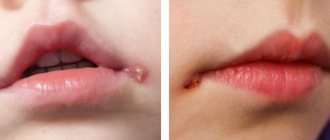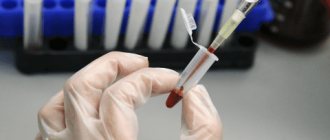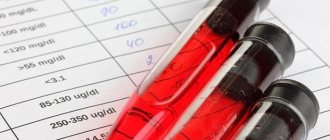Detailed description of the study
Normally, immunoglobulins, or antibodies, serve to protect against microorganisms, foreign substances and their possible negative effects on the body. Antibodies are synthesized by a special type of lymphocyte - plasma cells and are divided into five main classes, which are usually designated as IgA, IgG, IgD, IgE and IgM. They differ in their structure, concentration in the blood and functions performed.
In autoimmune diseases, the body produces pathological immunoglobulins (autoantibodies). They trigger a cascade of reactions aimed at destroying their own cells and tissues. The reasons and exact mechanisms of this process are not fully known. However, there are a number of predisposing factors, which, for example, include genetic predisposition: the presence of autoimmune pathology in blood relatives.
Antinuclear factor is a group of antibodies to components of the cell nucleus, which serves as a marker for the presence of autoimmune diseases. Which include:
- Systemic lupus erythematosus (SLE);
- Sjögren's syndrome;
- Systemic scleroderma;
- Mixed connective tissue diseases (MCTD), or Sharp's syndrome;
- Inflammatory myopathies (polymyositis, dermatomyositis).
The study consists of identifying pathological immunoglobulins that interact with the components of the cell nucleus: DNA, RNA and proteins. Therefore, these immunoglobulins are called antinuclear antibodies (ANA), and their combination is called antinuclear factor (ANF).
The peculiarity of the test is that a special culture of HEp-2 cells, originally obtained from laryngeal cancer cells, is used as a substrate for the immune response. HEp-2 cells have a large nucleus that is clearly visible under a microscope and are always located on glass slides in one layer.
During the study, 6 types of luminescence were identified: homogeneous, peripheral, speckled, reticulated speckled, discrete speckled and nucleolar. The nature of the glow reflects the presence of different types of antinuclear antibodies. The type of antibody glow is associated with one or another rheumatic pathology, and therefore makes it possible to clarify the diagnosis.
Determination of antinuclear factor using a special culture of HEp-2 cells and determination of 6 types of luminescence is necessary as part of a diagnostic search for suspected rheumatological diseases. For a number of diseases, this test is considered as one of the mandatory diagnostic criteria.
The sensitivity of the method for detecting rheumatic diseases has a high percentage, which for systemic lupus erythematosus is 93%.
In the Hemotest laboratory, the antinuclear factor on the HEp-2 cell line with the determination of 6 types of luminescence is determined using modern and accurate equipment and is quite affordable.
INTERPRETATION OF RESULTS.
In healthy individuals under 60 years of age, negative results for antibodies to nuclear and cytoplasmic components should be expected; in a low titer (weakly positive result), these antibodies are still found in 2-3% (according to some data, up to 10%) of practically healthy people, but it is never possible to predict whether these people will develop an autoimmune disease in the future (so, according to According to some authors, antibodies to DNA begin to be detected long before the onset of clinical manifestations of SLE; the latent period can last for years). After 60 years, the frequency of weakly positive results constantly increases with age. The clinical significance of these results remains unclear; as a rule, they are detected only in the primary (screening) dilution of 1:40. Based on this, if a positive result is detected at a screening titer of 1:40, titration is always necessary, at least to a diagnostic titer of 1:80. In any case, it seems advisable to carry out regular clinical and laboratory follow-up of individuals who have been diagnosed with low-titre ANA. LIMITATIONS OF THE METHOD A positive result suggests the presence of certain diseases (see below), however, like the result of any laboratory tests, it may require confirmation or clarification using other methods, as well as the establishment of clinical and laboratory correlations. It should be borne in mind that various drugs can cause the formation of autoantibodies (hydralazine, procainamide, phenytoin, carbamazepine, isoniazid, chlorpromazine, penicillamine, levodopa, penicillin, phenylbutazone, oral contraceptives, quinidine). The most common targets of these iatrogenic autoantibodies are nuclear histones, which leads to the development of a homogeneous or homogeneous peripheral type of luminescence.
References
- Federal clinical guidelines. Laboratory diagnosis of rheumatic diseases. Moscow, 2014.
- Rheumatology: national guide / ed. E.L. Nasonova, V.A. Nasonova. - M.: GEOTAR-Media, 2008. - 720 p.
- Lapin, S.V., Totolyan, A.A. Immunological laboratory diagnosis of autoimmune diseases. - St. Petersburg: Man, 2010. - 272 p.
- Lapin, S.V. Detection of antinuclear antibodies: international recommendations and personal experience, 2014.
- Rheumatic diseases: nomenclature, classification, standards of diagnosis and treatment / ed. V.N.Kovalenko, N.M. Shuba. - M.: Katran group, 2002. - 214 p.
Description
Synonyms (rus): Antinuclear antibodies, ANF, ANA
Synonyms (eng): ANA, antinuclear antibodies
Biomaterial: Venous blood
Indicator(s): Autoantibodies to nuclear and cytoplasmic antigens
Method(s): Indirect immunofluorescence reaction
Container type and preanalytical features: Biochemical tube with coagulation activator, 6 ml (red or brown cap)
Antinuclear antibodies are a family of autoantibodies directed against various cellular structures, including the nucleus, nuclear membrane, mitotic apparatus, cytoplasmic components, and cell membranes. Antinuclear factor (ANF) is an immunofluorescence test on continuous human cell lines and is the main method for detecting antinuclear antibodies. Antibodies are detected by their binding to antigens of the HEp-2 cell line. ANF is recommended as a screening test for antinuclear antibodies by both many national guidelines and international guidelines (Nancy Agmon-Levin et al, 2013). ANF titer >80 is included in the new 2021 EULAR/ACR classification criteria for systemic lupus erythematosus. In combination with ANF, it is recommended to conduct a study of antibodies to the extractable nuclear antigen (ENA screen). Detection of ANF requires establishing the specificity of autoantibodies using a number of clarifying tests, namely immunoblot of antinuclear antibodies, immunoblot of antinuclear antibodies for systemic scleroderma, immunoblot for inflammatory myopathies. In some cases, the antigenic specificity of ANF cannot be established due to serological reactions against conformational, soluble or uncharacterized antinuclear antibody antigens. The distribution of antigens inside the cell determines the type of nuclear luminescence, which allows one to judge the spectrum of antinuclear antibodies present in a given serum. Glow types are indicated according to the recommendations of the International Consensus Group on Glow Types ANF (https://www.anapatterns.org).
Antiperinuclear factor, IgG
Antiperinuclear factor is a type of anticitrullinated autoantibody that is a marker of rheumatoid arthritis.
Synonyms Russian
APF.
English synonyms
Antiperinuclear factor (APF).
Research method
Indirect immunofluorescence reaction.
What biomaterial can be used for research?
Venous blood.
How to properly prepare for research?
- Do not smoke for 30 minutes before the test.
General information about the study
Antiperinuclear factor (ACE) is a type of autoantibody directed against citrulline-containing proteins. Anti-citrullinated antibodies also include anti-keratin antibodies (AKA) and anti-central citrullinated peptide (ACCP) antibodies, which are markers of rheumatoid arthritis (RA) and are often measured simultaneously.
Rheumatoid arthritis (RA) is a chronic systemic autoimmune disease. It is characterized by inflammation, pain, stiffness, destruction and deformation of the affected joints. Most often it is found in women aged 40-60 years. Any joints can be involved in the pathological process. The disease can progress rapidly, cause significant changes in the joints, or remain in remission (a period of temporary weakening) for many years. Early diagnosis of RA and timely initiation of treatment are very important, since if left untreated, it can lead to limited physical activity, disability, and even shortened life expectancy.
ACE, like other anticitrullinated antibodies, binds filaggrin, the antigenic properties of which are determined by citrulline. Citrulline is a non-standard amino acid; it is not part of synthesized proteins and is not capable of being formed during the modification of arginine. The citrullination reaction—the formation of citrulline—plays an important role in cell differentiation and apoptosis (programmed cell death). The pathogenetic significance of anticitrulline antibodies in the development of rheumatoid arthritis is not fully understood and is probably associated with the accumulation of citrulline in the inflamed synovium, the triggering of apoptosis and immunological cross-reactions.
Antiperinuclear factor was first described by Nienhuis and Mandema in 1964 as a specific marker of rheumatoid arthritis. It is detected using an indirect immunofluorescence reaction in keratohyalin granules surrounding the nucleus of human cheek epithelial cells. In this case, under a microscope, a specific glow of round granules (3-8 per cell) located around the nucleus is determined.
ACE is characterized by higher specificity than rheumatoid factor (RF), but lower sensitivity. The ACE level is not interrelated with RF titers, which allows this test to be used in seronegative RA as an independent marker. This analysis is of great importance in the diagnosis of early RA. The sensitivity of ACE is 53-68%, specificity is 91-95%.
The antiperinuclear factor test is often ordered at the same time as the antikeratin antibody test. ACEs and AKAs are found significantly more often than RF at the onset of RA; they are observed in 38% of patients with seronegative RA.
ACE and other anticitrullinated antibodies are detected in patients with greater disease activity, aggressive course of RA and severe articular syndrome, higher parameters of functional failure, progressive radiological changes and resistance to basic therapy.
ACE in some cases can be positive in healthy people, in people with other autoimmune diseases, so the test results should be assessed in conjunction with the history and symptoms, as well as with data from other tests and instrumental examination methods.
What is the research used for ?
- For the diagnosis of early rheumatoid arthritis.
- For the diagnosis of seronegative rheumatoid arthritis.
- For differential diagnosis of diseases with joint damage.
- To make a prognosis for rheumatoid arthritis.
When is the study scheduled?
- For symptoms of rheumatoid arthritis (swelling, pain in the joints of the hands, stiffness in the movement of inflamed joints, increased body temperature, subcutaneous rheumatic nodules).
- When examining a patient with articular syndrome of unknown origin.
- With negative rheumatoid factor in a patient with articular syndrome.
- When examining a patient with radiological signs of erosion of the articular surfaces of bones.
What do the results mean?
Reference values:
Reasons for the increased result:
- rheumatoid arthritis,
- psoriatic arthritis (about 8% of cases),
- systemic lupus erythematosus (rare),
- Sjögren's syndrome (rare)
- diffuse toxic goiter (rare),
- viral hepatitis C (very rare).
Important Notes
- The anti-cyclic citrulline-containing peptide (CCP) antibody test is considered a more sensitive diagnostic method, but there is a small percentage of patients with rheumatoid arthritis in whom a negative ACPP is detected with a positive ANP.
- This test is used only to clarify the diagnosis and prognosis of the course of the disease, and not to assess the effectiveness of therapy.
Also recommended
- Rheumatoid factor
- Antibodies to cyclic citrulline-containing peptide, IgG
- Antikeratin antibodies (AKA)
- Joint determination of antikeratin antibodies and antiperinuclear factor
- Anti-double-stranded DNA (anti-dsDNA) screening
- Antibodies to nuclear antigens (ANA), screening
- Antibodies to extractable nuclear antigen (ENA screen)
- Antistreptolysin O
- Anti-citrullinated vimentin antibodies (anti-MCV)
- C-reactive protein, quantitative
- Circulating immune complexes (CIC)
- Protein fractions in whey
- anti-HCV, antibodies
- Complete blood count (without leukocyte formula and ESR)
- Erythrocyte sedimentation rate (ESR)
Who orders the study?
Rheumatologist.
Literature
- Kim DA, Jearn LH, Kim TY. Antiperinuclear factor test is more useful than anti-Sa assay when used with anti-cyclic citrullinated peptide test in diagnosis of rheumatoid arthritis. J Rheumatol. 2007 Sep;34(9):1944-5.
- Nienhuis RL, Mandema E. A new serum factor in patients with rheumatoid arthritis, the antiperinuclear factor // Ann. Rheum. Dis. – 1964. – Vol. 23. – P. 302-305.
- Rheumatology. Edited by Hochberg M. and others. 5th edition. Mosby Elsevier – 2010 – pp. 261-262.
- Schellekens GA, de Jong BA, van den Hoogen FH et al. Citrulline is an essential constituent of antigenic determinants recognized by rheumatoid arthritis specific autoantibodies // J. Clin. Invest. – 1998. – Vol. 101. – P. 273-281.
- Maslyansky A.L., Lapin S.V., Ilivanova E.P., Mazurov V.I., Totolyan A.A. Antikeratin antibodies and antiperinuclear factor are markers of the aggressive course of rheumatoid arthritis. Medical immunology, 2003, T. 5, No. 5-6. – pp. 599-608.
Indications
It is advisable to study the antinuclear factor in the following cases:
- Diagnosis of autoimmune and some other systemic diseases without pronounced symptoms;
- Comprehensive diagnosis of systemic lupus erythematosus, its form and stage, as well as the choice of treatment tactics and prognosis;
- Diagnosis of drug-induced lupus;
- Preventive examination of patients diagnosed with lupus erythematosus;
- The presence of specific symptoms: prolonged fever without an established cause, pain and aches in joints, muscles, skin rashes, increased fatigue, etc.;
- The presence of symptoms of systemic diseases: damage to the skin or internal organs (kidneys, heart), arthritis, epileptic seizures and convulsions, fever, causeless increase in temperature, etc.;
- Prescribing drug therapy with disopyramide, hydralazine, propafenone, procainamide, ACE inhibitors, beta blockers, propylthiouracil, chlorpromazine, lithium, carbamazepine, phenytoin, isoniazid, minocycline, hydrochlorothiazide, statins, since there is a risk of developing drug-induced lupus erythematosus.
In what pathologies can Antinuclear Factor be detected in the blood?
Positivity for ANF on the HEp-2 cell line is observed in systemic lupus erythematosus (SLE), systemic rheumatic diseases and many autoimmune diseases, which makes it a universal test in the examination of patients with autoimmune pathology. A positive result of ANF is observed in more than 90% of patients with diffuse connective tissue diseases, such as systemic lupus erythematosus and cutaneous forms of this disease, scleroderma and its varieties, mixed connective tissue disease, Sjogren's syndrome. Detection of ANF is of great importance in the diagnosis of juvenile rheumatoid arthritis and autoimmune liver diseases. Representatives of this family of autoantibodies can be found in many other autoimmune (thyroiditis, diabetes), infectious (viral hepatitis), inflammatory and oncological diseases. The incidence of ANF reaches 1-3% in clinically healthy people and increases slightly in people over 65 years of age. Individuals with high ANF titers are at increased risk of developing autoimmune diseases.
Norm for ANA and influencing factors
Normally, antinuclear antibodies in plasma are absent or detected in small quantities. The result depends on how the test is performed:
1. The test was done using the ELISA method
- less than 0.9 points - negative (normal);
- from 0.9 to 1.1 points - doubtful (it is recommended to repeat the test in 7-14 days);
- more than 1.1 points - positive.
2. For quantitative analysis of RNIF, a titer of less than 1:160 is considered the norm. 3. Immunoblotting - normal -not detected- (general conclusion / opposite to each type of antibody).
For what purpose is Antinuclear Factor determined?
Antinuclear factor (ANF) testing is the main method for detecting antinuclear antibodies, allowing the detection of autoantibodies to nucleic acids (dsDNA, ssDNA, RNA), ribonucleoproteins, as well as most conformational and insoluble antigens. Antinuclear antibodies in this method are detected due to their binding to intracellular antigens of a continuous human epithelial cell line (HEp-2). The nucleus and cytoplasm of HEp-2 cells contain all antigens characteristic of a human cell, which makes it possible to detect all major antinuclear antibodies in one test. The method of indirect immunofluorescence on the HEp2 cell line is recommended as the gold standard for the detection of antinuclear antibodies by leading experts, including European (EASI group 2010) and American expert groups (ACR ANA Task force 2008). Due to the diversity of antinuclear antibody antigens, not all of them can be purified or synthesized for use in automated enzyme immunoassays for detecting antinuclear antibodies (such as No. 125 Antinuclear antibodies, ELISA screening). In turn, easily soluble components of the cell nucleus can be lost from cell nuclei when fixing the preparation for conducting ANF studies by indirect immunofluorescence (No. 1267). Therefore, the use of ELISA methods (antibodies to extractable antigens - ENA, antinuclear antibodies, ELISA - ANA No. 125) in combination with the detection of antinuclear factor on HEp2 line cells by indirect immunofluorescence (ANF No. 1267) allows one to avoid false-negative test results in systemic rheumatic diseases diseases.
Interpretation
A negative antinuclear factor (ANF) result excludes with a probability of up to 90% the diagnosis of systemic lupus erythematosus, diffuse scleroderma, Sjogren's syndrome, CREST syndrome, mixed connective tissue disease, juvenile rheumatoid arthritis, and also with a probability of up to 80% - the most common forms of autoimmune lesions liver, including autoimmune hepatitis type 1 and primary biliary cirrhosis. The type of glow in case of a negative result is not determined. The result of this test may be false negative for a number of cytoplasmic antigens (antibodies to ribosomal P protein, Jo-1), as well as for the detection of ANF in some groups of patients. For example, in the case of ANF screening testing in children (<16 years), the reference value may be lower (<40). A positive antinuclear factor (ANF) test indicates the presence of antinuclear antibodies and is usually seen in patients with systemic autoimmune diseases. With the highest frequency, ANF is observed in diffuse connective tissue diseases (85-90%), autoimmune liver diseases (70-80%), oligoarticular juvenile rheumatoid arthritis (90%), rheumatoid arthritis (30%), inflammatory myopathies (40%), Raynaud's syndrome (15-20%) and autoimmune thyroid diseases (20%). Detection of ANF plays an important role in the diagnosis of autoimmune hepatitis type 1. Low ANF titers are often observed against the background of infectious and oncological diseases. In clinically healthy individuals, the frequency of low ANF titers is up to 10%; in old age, the likelihood of detecting ANF increases significantly.
Brief description of the analyte Antinuclear factor
In systemic lupus erythematosus (SLE) and other systemic rheumatic diseases, the immune response is directed against nucleoprotein antigens, i.e. complexes of nucleic acids and proteins. Such endogenous nucleoprotein autoantigens can be formed during the process of apoptosis of epithelial cells (a cascade of genetically programmed reactions leading to the removal of a damaged or defective cell) and resemble foreign viral particles. Acceleration of apoptotic processes under the influence of ultraviolet irradiation, viral infections or drugs, simultaneously with impaired or delayed removal of apoptotic products, triggers autoimmune responses in SLE. Nucleoprotein antigens condense into apoptotic bodies, which become targets for autoantibodies.
Currently, about 200 types of antibodies to nucleoproteins and ribonucleic acids, which are called antinuclear antibodies, have been described. In autoimmune diseases, autoantibodies to nuclear antigens do not have a direct cytotoxic effect on human cells, but immune complexes are capable of triggering immunological inflammation, especially in places where the vessels are particularly thin, including the kidneys, skin, central nervous system, synovium of joints, pleura .







